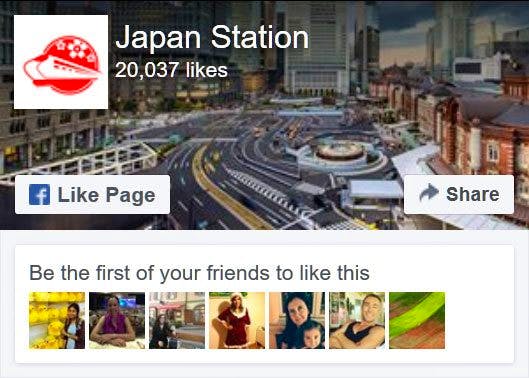One of the best ways to get to know Asakusa is through its food. Indeed, the downtown cuisine of Asakusa and its many historic eateries attracts food-lovers from all over the world. In this article we introduce Asakusa’s best restaurants and classic Asakusa dishes such as loach stew, monjayaki pancakes, broiled eel, and sukiyaki. Also on the list are Japan’s oldest Western-style bar, and an Edo era storehouse renovated as a café for art lovers. This corner of Tokyo has something to suit every taste, so take your pick from our selection below and enjoy the best of Asakusa’s gourmet culture.
1. Edo Monja Hyotan
Edo Monja Hyotan is a friendly and casual restaurant which specializes in monjayaki: a type of savory pancake which has been popular in Tokyo since the Edo era.
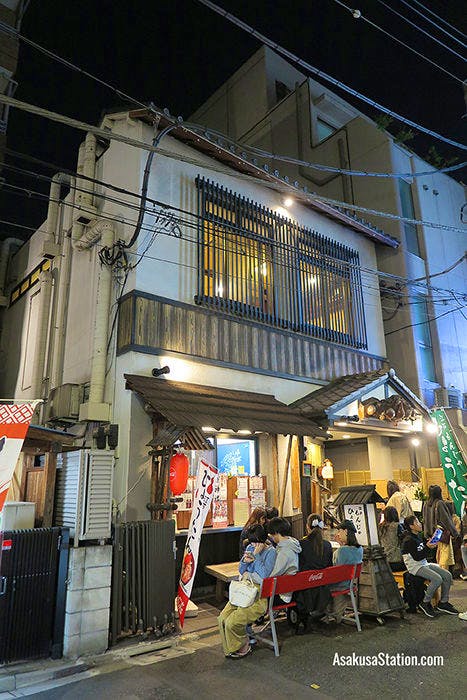
Edo Monja Hyotan
Monjayaki is similar to okonomiyaki and like okonomiyaki it is cooked on a hotplate. However, because monjayaki has dashi (a type of fish stock) as one of its basic ingredients monjayaki has a more fluid consistency. When making okonomiyaki all the ingredients are mixed into the batter before cooking. When making monjayaki, most of the ingredients are kept separate from the batter, and placed on the hot plate first. They are then shaped into a ring and the batter is poured into the middle. When the batter begins to bubble, it can be mixed up together with the other ingredients. Diners then eat directly from the hotplate using small spatulas. Typical ingredients used to add flavor to monjayaki are chopped cabbage and other vegetables, and other items that the customer chooses such as seafood, pork, cod roe, or cheese.
Edo Monja Hyotan is one of the more famous monjayaki restaurants in Asakusa, and is well-known for its large servings, reasonable prices, and its special soy-based monja sauce. Each table comes with its own hotplate for cooking your food, and the staff are very friendly so they will be happy to show you how to cook your own monjayaki. The recommended shop specialties are the curry flavored monjayaki, and the “mentai mochi cheese monja” which includes spicy cod roe and sticky rice cakes.
Location
Edo Monja Hyotan is located on a side street just off the west side of Nakamise shopping street. Here is a map of the location.
Address: 1-37-4 Asakusa, Taito City, Tokyo 111-0032
Opening Hours: 11.00 – 21.00 (Last Orders 20.00)
Closed: the 2nd & 4th Tuesday of each month
2. Imahan Honten
First established in 1895, this family-run sukiyaki restaurant has been operating in the current location since 1951. The restaurant building still retains an old-fashioned Show era atmosphere with traditional furnishings and a delightful interior garden. Although, this is a very traditional Japanese restaurant, both Japanese style seating on tatami floors and Western style seating with tables and chairs is available.
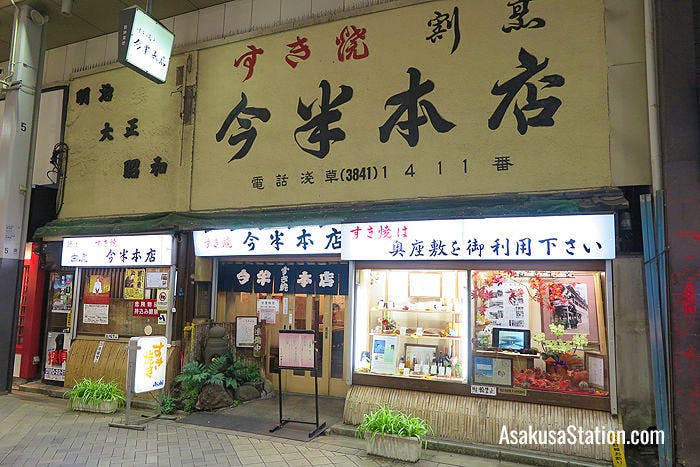
Imahan Honten
At Imahan Honten the sukiyaki is cooked at your table. The finest cuts of wagyu beef are slowly simmered in a shallow pot with cabbage, onions, and seasonings, and when ready to eat are dipped in beaten egg. Three sukiyaki meals are available. The standard sukiyaki meal costs 3,240 yen, “Jo-sukiyaki” using high grade beef costs 4,320 yen and is the most popular choice, and the “Special Sukiyaki” uses the finest quality sirloin and costs 6,480 yen. If you want to save some money, there is also a lunchtime set meal called the “sukiyaki teishoku” which costs only 2,200 yen, however, this is only available on weekdays.
Imahan Honten should not be confused with Asakusa Imahan, which is another sukiyaki restaurant on the west side of Asakusa, or Imahan Bekkan which is located further north. These three restaurants all serve sukiyaki, but they are completely separate businesses.
Imahan Honten does not accept credit card payments.
Location
Imahan Honten is located on the south side of Shin-Nakamise shopping street, on the east side of Nakamise. Here is a map of the location.
Address: 1-19-7 Asakusa, Taito City, Tokyo
Opening Hours: 11.00 – 22.30 (Last order at 22.00)
Closed: Tuesdays, national holidays, and during local festivals.
3. Komakata Dozeu
Komakata Dozeu is a traditional Japanese restaurant specializing in meals that feature a type of fresh water fish called “dojo” in Japanese, or “loach” in English. Loach is packed with nutritious minerals and vitamins, has a similar taste to eel, and was a popular food for local townsfolk during the Edo era. Komakata Dozeu is a genuine Edo era restaurant, as it first opened in 1801. When you eat at Komakata Dozeu, you are eating the same menu that was served over 200 years ago. The wooden restaurant building also retains its original Edo era appearance and atmosphere.
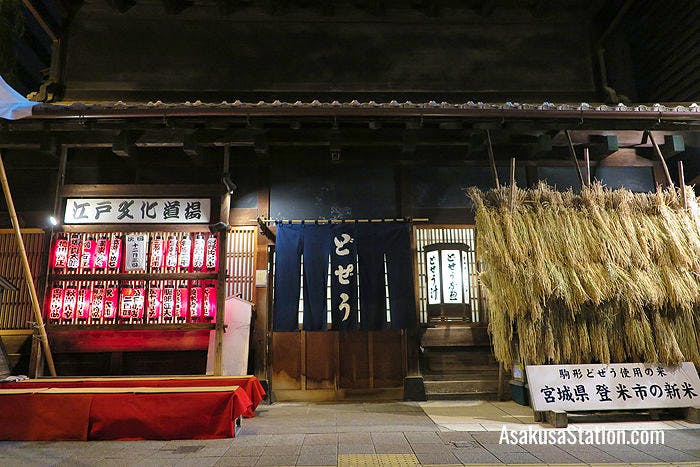
Komakata Dozeu
On the first floor customers sit on cushions on the tatami matted floor. On the 2nd floor and basement levels there are tables and chairs. Diners are served by waiting staff in kimonos, and English menus are available. This restaurant’s most popular dish is “Dojo Nabe” which is a kind of loach stew that is simmered on a small charcoal brazier at your table. The loach are first soaked in sake before being slow-cooked in a miso broth, and then topped with miso sauce and green onions. The loach have a unique savory taste, and when cooked this way they are so soft that they melt in your mouth.
Other menu options include the “Yanagawa Nabe” which is another loach stew with fluffy egg and grated burdock root, “Dozeu Kabayaki” which is grilled loach in a sweet soy-based sauce, and “Dozeu Kara-age” which is deep-fried loach. This restaurant also has a nice selection of sake rice wine to complement these dishes, so be sure to ask for your waiter’s recommendation.
Location
Komakata Dozeu is located on the west side of Edo-dori Avenue, about a 10 minute walk south of Tobu Asakusa Station. Here is a map of the location.
Address: 1-7-12 Komagata, Taito City, Tokyo 111-0043
Opening Hours: 11.00 – 21.00
Closed: New Year’s Eve and New Year’s Day.
4. Daikokuya Tempura
Daikokuya Tempura serves a variety of meals featuring tempura: deep fried battered prawns and assorted seafood and vegetables. However, the specialty at Daikokuya Tempura is “tendon” which is tempura served on a bowl of freshly cooked rice. The tempura here is fried in sesame oil till it is a deep golden-brown and served with the restaurant’s special dipping sauce which is renowned for its rich and salty-sweet flavor.
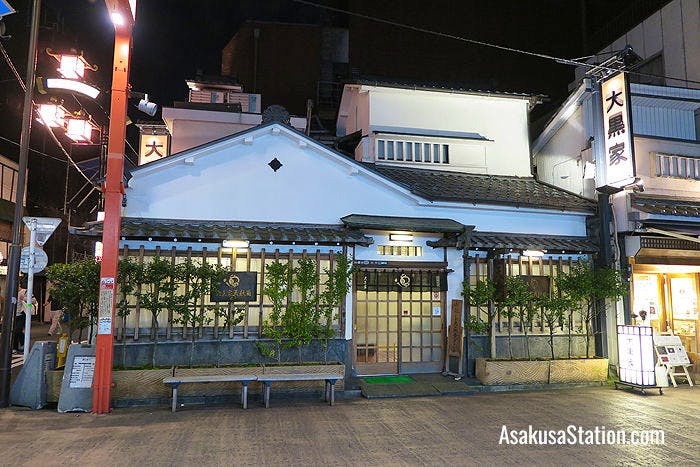
Daikokuya Tempura
Daikokuya Tempura opened in 1887 as a soba noodle restaurant, but when the owners noticed how popular their tempura soba was, they changed from a noodle restaurant to focus on the tempura. Today, this restaurant is popular with both locals and sightseers and is popularly believed to serve the best tempura in Tokyo.
Meals here are reasonably priced, the atmosphere is relaxed and friendly, and an English menu is available. Only a short walk from Nakamise shopping street and Sensoji temple, this is a convenient spot for lunch after visiting the local sightseeing attractions.
Location
Daikokuya Tempura is located on the south side of Denboin Street. Here is a map of the location.
Address: 1-38-10 Asakusa, Taito City, Tokyo 111-0032
Opening Hours: 11.00 – 20.30 (until 21.00 on Saturdays and holidays / open every day)
5. Koyanagi
Koyanagi is a famous eel fillet restaurant in Asakusa that was first established in 1926. Here, the eel fillets are cooked by being grilled and then steamed to produce a rich flavor and tender consistency. They are then served with Koyanagi’s special house-made sauce which is well-known for its light, subtle taste that brings out the deep, savory flavors of the eel.

Koyanagi
At this restaurant you can eat eel fillets in three different ways: shirayaki, kabayaki, and unaju. Shirayaki is grilled eel without any sauce, kabayaki is grilled eel with sauce, and unaju is basically the same as kabayaki, but served on a bed of white rice in a lacquer box. For both the kabayaki and the unaju there are two grades of service which are called matsu and take. For the matsu grade you pay a higher price, but you get more food. Be sure to order a refreshing bowl of “kimosui” or eel liver soup to accompany your meal as it is both cheap and tasty.
Location
Koyanagi is located on a side street on the west side of Nakamise. Here is a map of the location.
Address: 1-29-11 Asakusa, Taito City, Tokyo 111-0032
Opening Hours:
Monday – Friday: 11.30 – 15.00 (Last Orders: 14.30) and 16.00 – 21.00 (Last Orders: 20.30)
Sundays & Holidays: 11.30 – 21.00 (Last Orders: 20.30)
Closed on Thursdays
6. Asakusa Mugitoro Honten
Asakusa Mugitoro Honten is the main branch of this restaurant which first opened in 1929. Mugitoro’s specialty dish is “mugitoro gohan” which is rice cooked with barley grains and topped with a grated yam sauce called “tororo”. This simple dish is packed with nutritious minerals, vitamins, and fiber and the sticky, creamy tororo sauce is quite delicious.
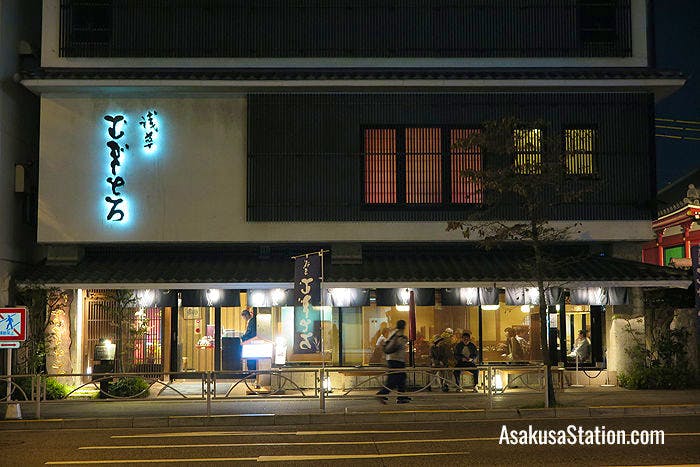
Asakusa Mugitoro Honten
Asakusa Mugitoro has a variety of meal options to suit all budgets. There is a lunchtime all-you-can-eat buffet deal on the 1st floor for 1,000 yen. This buffet includes mugitoro gohan, and also has flavored yam, miso soup, rolled omelet, pickles and other side dishes. For 2,000 yen you can get another buffet deal on the upper floor Lounge Vista section of the restaurant. This 2,000 yen buffet deal has more yam dishes to choose from, more side dishes, and includes desert and a soft drink. The 1st floor buffet lunch is only available on weekdays between 11.00 and 13.30. The Lounge Vista buffet lunch is available from 11.00 to 15.00 from Monday to Saturday, and from 11.00 to 16.00 on Sundays.
For both lunch and dinner there are also a variety of set meal and a la carte options, and complete kaiseki multi-course meals which range in price from 2,000 to 15,000 yen.
Location
Asakusa Mugitoro is located on the east side of Edo-dori Avenue, about a 5 minute walk south of Tobu Asakusa Station. Here is a map of the location.
Address: 2-2-4 Kaminarimon, Taito City, Tokyo 111-0034
Weekday Opening Hours: 11.00 – 16.00 (Last Orders at 15.00) and 17.00 – 22.30 (Last Orders: 21.00)
Weekends & Holidays: 11.00 – 22.30 (Last Orders: 21.00)
7. Asakusa Menchi
Asakusa Menchi is a famous shop in Asakusa selling a special kind of deep-fried ground meat cutlet which is called “menchi-katsu” in Japanese. The cutlets at Asakusa Menchi are renowned for their rich flavor and for the exceptional sweetness of the meat, and so the store has become incredibly popular. There is often a long line of customers at the front counter, waiting to buy this unique take-away snack.
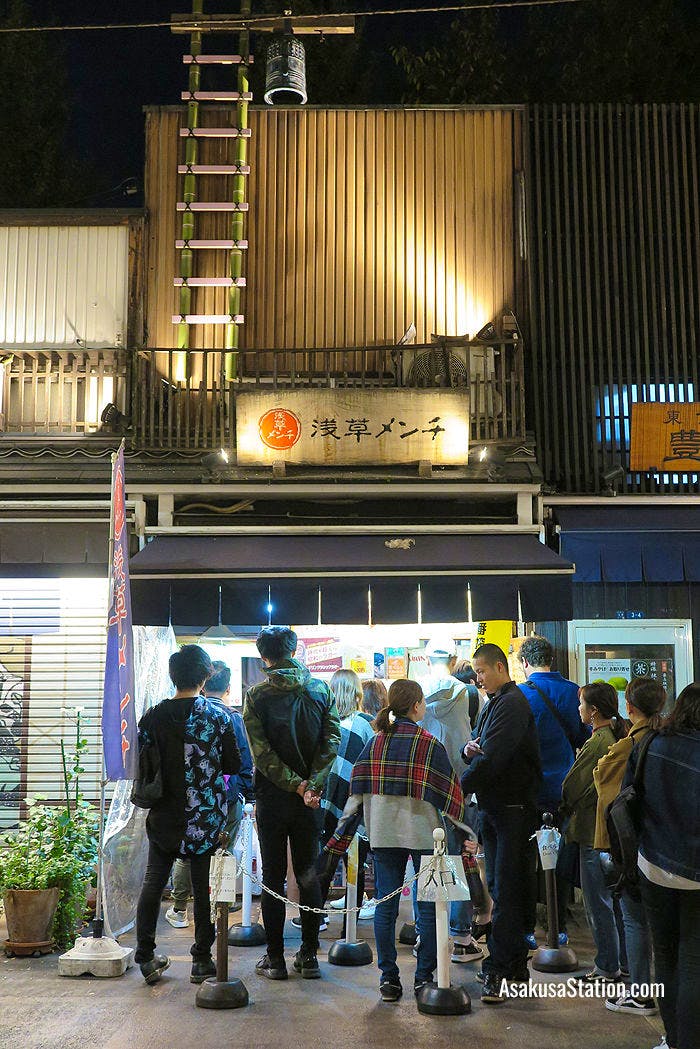
Folks lining up for Asakusa Menchi
Asakusa Menchi blends ground beef with the highest grade of Koza brand pork from Kanagawa Prefecture. This particular type of pork is famous for its smooth, tender texture, and its exquisite juicy flavor. Finely chopped sweet onions are then added to the special meaty mix, before coating each meat patty in bread crumbs, and deep-frying it till crispy golden-brown.
One menchi-katsu cutlet will cost you 250 yen. Usually menchi-katsu are eaten with some form of sauce. The recommended way to eat this shop’s cutlets however, is either on their own in order to enjoy their full flavor, or with a dash of mustard to add some zing to your palate. The best time to eat these cutlets is while they are hot. Although, this is a take-away food, there is a small seating area a couple of doors down from the shop where you can stop to eat your cutlets while they are still fresh.
Location
Asakusa Menchi is located on the north side of Denboin Street, just a short walk from the Nakamise shopping street. Here is a map of the location.
Address: 2-3-3 Asakusa, Taito City, Tokyo 111-0032
Opening Hours: 10.00 – 19.00 (open every day)
8. Kamiya Bar
Kamiya Bar first opened in 1880 and is believed to be Japan’s oldest Western-style bar. The current building dates from 1921 and is registered as a National Tangible Cultural Property. This is a great spot to experience a real “shitamachi” or downtown social atmosphere, and it offers a literal taste of history, as some of the drinks on offer date all the way back to Japan’s 19th century Meiji period.
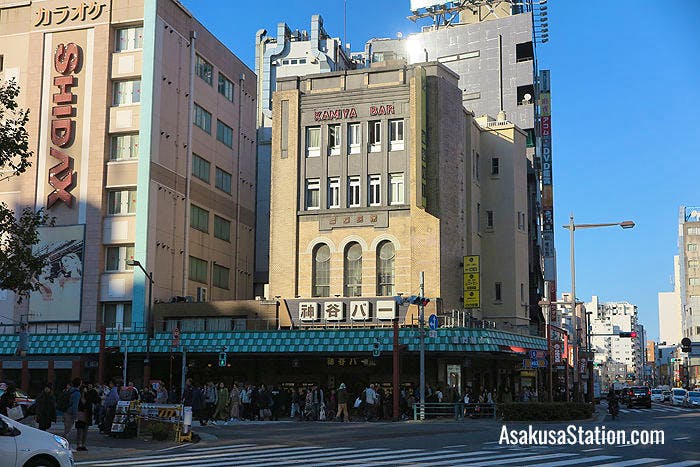
Kamiya Bar
The bar on the first floor is the main attraction. Here the atmosphere is lively, and the tables are clustered close together, so friendly conversations with your neighbors are routine. The general high spirits are encouraged by cheap drinks, with draft Asahi beers taking precedence because the brewery is located nearby. The largest beer stein is called a “daijokki” and holds a full liter of beer for just 1,080 yen. For those who are not Asahi beer fans, then bottled Guinness and Peroni are on the beer list and wine and whisky are also available.
Kamiya Bar is also famous for “Denki Bran” (or “electric brandy”), which is a sweet blend of brandy with gin, wine, curacao, and medicinal herbs. This unique drink got its name back in the Meiji era, when electricity was a symbol of modernity. Today, you can get a standard glass of Denki Bran (which is 30% alcohol) for just 270 yen, or a glass of “Denki Bran Old” (which is 40% alcohol) for 370 yen. Alternating draft beer with a chilled glass of Denki Bran is said to be the “Kamiya style”. Denki Bran based cocktails are also available.
Another Meiji era drink at Kamiya Bar is the Hachibudo-shu, which is wine sweetened with honey and flavored with medicinal herbs. This drink was created at a time when Japanese people were drinking imported wine for the first time, and finding the flavor did not suit their sense of taste. To make it easier for Japanese people to drink, Hachibudo-shu was created, and it became an instant hit. At Kamiya Bar both red and white varieties of Hachibudo-shu are available. You can drink it straight or as a fruit punch mixed with soda water.
On the 1st floor food menu there are plenty of snacks, and light meal choices to help soak up the beer and brandy. One local favorite is “nikomi”, a stew of beef tendons in miso, soy sauce, and kelp. Another house specialty is the “German potatoes” which are deep-fried potatoes that have been sautéed with onions, bacon, and Worcester sauce. Other popular choices on the menu are yakitori chicken, crab croquettes, kushi-katsu style kebabs, and hamburger steak.
The 2nd and 3rd floors of the Kamiya Building are restaurant floors. The 2nd floor food menu serves mostly Western-style food, which is similar to what’s on the 1st floor food menu, but more extensive. The 3rd floor is a more sedate Japanese style restaurant serving set meals and full kaiseki courses featuring tempura, sashimi, and shabu-shabu. On the ground floor there is also a shop where you can buy souvenir bottles of Denki Bran, Hachibudo-shu, and Kamiya brand wine.
Location
Kamiya Bar is located on the corner of Kaminarimon-dori Street and Edo-dori Avenue. It is a short walk south of the Ekimise building and Tobu Asakusa Station, and right beside Exit 3 of Tokyo Metro Asakusa Station. Here is a map
Address: 1-1-1 Asakusa, Taito-ku, Tokyo 111-0032
Opening Hours: 11.30 – 22.00 (Last Orders: 21.30)
Closed on Tuesdays
9. Gallery éf
Formerly, the most famous café in Asakusa was Angelus. A classic Tokyo café, Angelus was first established in 1946, and was popular for its coffee and cakes, and known to be a favorite haunt of celebrity patrons such as Yasunari Kawabata and Osamu Tezuka. Sadly, Angelus was closed for good in March 2019. But there is still a café in Asakusa where you can enjoy great coffee, delicious cake, and a deep sense of history. That café is Gallery éf.
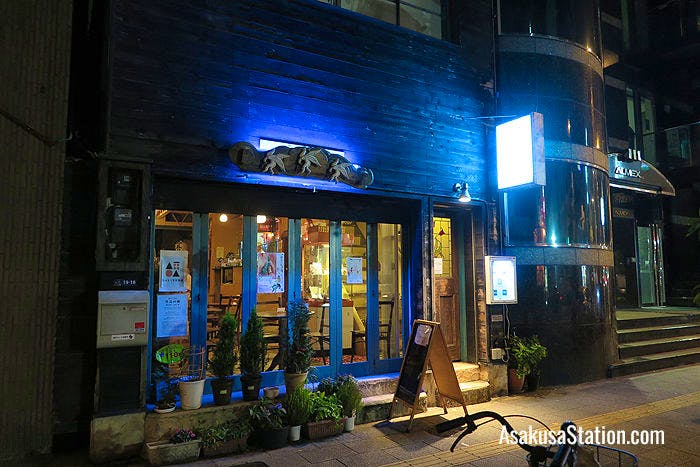
Gallery éf
Gallery éf is a 19th century family storehouse that has been repurposed as a café, bar, and art gallery. The storehouse was built in 1868 with a sturdy wooden frame (using no nails) and earthern walls. Somehow this building survived both the Great Kanto Earthquake of 1923 and the firebombing of Tokyo in 1945; both events which completely destroyed most of the surrounding area. This makes Gallery éf a very rare structure in Tokyo, and so it has been registered as National Tangible Cultural Property. In 1996 a group of artists and artisans worked together to restore the building, and in 1997 it was opened to the public as an art space and café. The gallery space is at the back of the café and holds exhibitions and occasionally live performances of jazz, folk, and classical music.
Inside the café you can sit among antique furnishings and admire the Edo era architecture with a high wood-beamed ceiling and the red lacquered floor. The café food menu includes simple meals of pasta and rice dishes, omelettes, and chili beans. More impressive are the delicious homemade desserts which include sponge cake, cheesecake, pound cake, and banana crepes with ice cream. Drinks include pour-over coffee, a variety of teas, juices, and other soft drinks. On the alcoholic beverages menu are local favorite Asahi Super Dry, Anchor craft beer from San Francisco, and a small selection of other international brews, plus whisky, and wine by the glass.
Location
Gallery éf is located on the west side of Edo-dori Avenue and is a 1 minute walk from A5 Exit of Toei Asakusa Station, and 3 minutes from Tobu Asakusa Station. Here is a map of the location.
Address: 2-19-18 Kaminarimon, Taito City, Tokyo 111-0034
Gallery Opening Hours: 12.00 – 19.00
Café Opening Hours: 11.00 – 19.00(Last Orders: 18.30)
Bar Opening Hours: 18.00 – 24.30 on Fridays, Saturday, and the day before national holidays.
Closed on Tuesdays
10. Isomaru Suisan
Our final recommendation has neither the history nor the classic status of the locations listed above, but it is a lot of fun, has super convenient opening hours, and is a magnet for seafood lovers.
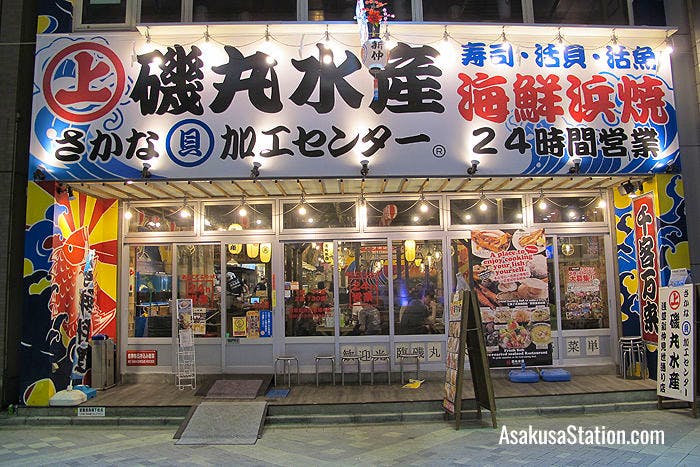
Isomaru Suisan
Isomaru Suisan is a casual izakaya style chain restaurant with multiple branches throughout Tokyo and two branches in Asakusa. This restaurant serves a huge variety of fresh fish and shellfish which are scooped directly from the on-site fish tanks. Isomaru Suisan is a “hamayaki” or “beach barbecue” style restaurant which means you cook your seafood yourself on a little grill at your table. The restaurant has a lively, cheerful atmosphere with colorful retro décor, and is open 24 hours a day. This makes it a very convenient late-night option for travelers. Prices are reasonable, the service is great, and English menus are available. Cheap all-you-can-drink deals are also on the menu.
Location
Isomaru Suisan has two branches in Asakusa. The Kannon-dori branch is convenient for the Tobu and Tokyo Metro Asakusa Stations and is close to the main sightseeing area. Here is a map showing the Kannon-dori branch’s location.
Address: 1-1-7, Asakusa, Taito City, Tokyo 111-0032
The Shin-Nakamise branch is convenient for TX Asakusa Station and Asakusa Rox. Here is a map< https://goo.gl/maps/BGkHC2uT8u3RaZuVA> showing the Shin-Nakamise branch’s location.
Address: 1-23-7 Asakusa, Taito City, Tokyo
Opening Hours: All branches are open 24 hours every day
Hoppy Street (Hoppy Dori)
Hoppy Street is Asakusa’s most famous location for eating, drinking and experiencing Tokyo’s downtown nightlife – and everything is cheap! This narrow street is located to the west of Sensoji Temple and runs from north to south for about 80 meters. On both sides, Hoppy Street is lined with cheap old-fashioned taverns, called izakaya, which are open day and night, and usually crowded with happy customers. Read more
Asahi Beer Tower, Asahi Beer Hall, Asahi Annex, and the Asahi Flame
Both Asahi Beer Hall and Asahi Beer Tower contain dining (and drinking) facilities. There is also a smaller annex on the other side of the Asahi Beer Hall where you can enjoy some original craft beers. Read more
Article and original photos by Michael Lambe. All rights reserved.
